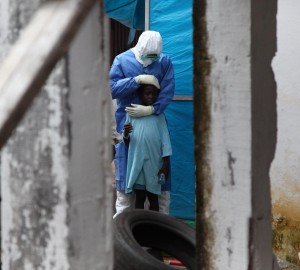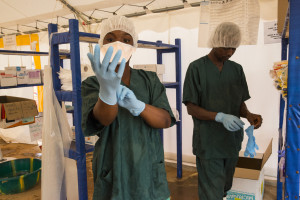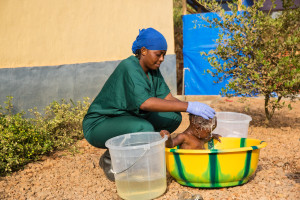EVD, formerly known as Ebola hemorrhagic fever, and commonly referred to as Ebola, is a severe, often fatal illness in humans. Ebola first appeared in Sudan and the Democratic Republic of the Congo (known at that time as Zaire) in 1976.
Ebola is transmitted to people through contact with wild animals—especially primates and bats, the latter of which are believed to be the reservoir host—and spreads person-to-person throughout a human population by close contact with bodily fluids. In the 2014–15 Ebola outbreak in West Africa, one in two people have survived the disease, when provided supportive treatment.
There is currently no cure for Ebola. However, if the sick person is treated early with constant hydration—people with Ebola can lose about 8-10 liters of fluid a day through vomiting and/or diarrhea—the chances of survival increase. At the moment, several clinical trials on a variety of treatment options and a number of vaccine trials are currently ongoing and are showing promise.
Symptoms for Ebola include fever, severe headache, muscle pain, weakness, fatigue, diarrhea, vomiting and stomach pains. In the latter stages particularly, symptoms also include rashes, hiccups, and unexplained bruising or hemorrhaging.
Unfortunately, the early signs and symptoms (fever, body aches, and general weakness and fatigue) are also common in diseases such as malaria and typhoid fever—diseases endemic to the countries currently affected by Ebola. Therefore, it is important for potentially infected individuals to report whether or not they have had contact with the blood or body fluids of a person sick with Ebola, contact with objects that have been contaminated with the blood or body fluids of a person sick with Ebola (e.g., clothing or bedding), or contact with infected animals.
The incubation period for Ebola is 2 to 21 days from the time a person has been exposed to the virus to the onset of symptoms. A person who is infected with Ebola can only spread the disease at the point that he or she starts to show symptoms.
While Ebola is a zoonotic disease, the most common form of transmission of Ebola is through direct contact with a person who is symptomatic (i.e. showing symptoms). Direct contact means contact through broken skin or mucous membranes with body fluids such as blood, urine, feces, saliva, vomit, sweat and/or semen of a person ill or dead. To date, no compelling evidence exists that suggests EVD is spread through air.
The more symptoms a person has, the greater the amount of virus that person is shedding. At the time a person dies from Ebola, he/she is shedding the most amount of virus. This is the primary reason why safe burial practices are so important. Items contaminated with blood or body fluids are also vectors of transmission for Ebola including, for example, bedding and clothing.
Of particular interest is evidence that Ebola remains in semen fluids for at least up to three months after the onset of symptoms, how much longer than that has still to be determined.
Although many people die from Ebola, recovery is possible and depends on early and consistent hydration, good supportive clinical care and a patient’s immune response. It also appears that children are more resilient to Ebola than adults. People who recover from EVD infection, generally referred to as Ebola survivors, develop antibodies that last at least 10 years.
The first reports of Ebola in the recent West Africa epidemic came from Guinea in December 2013. One year later, the disease had spread to a total of nine countries, namely Guinea, Sierra Leone, Liberia, Nigeria, Senegal, the United States, Spain, Mali and the United Kingdom. A separate outbreak occurred in the Democratic Republic of the Congo (DRC). Unlike past Ebola outbreaks, which were small in comparison and in remote locations in African countries like the DRC or Uganda, this one had penetrated urban areas with large populations and crossed borders and oceans.
The outbreak started in an area with highly mobile populations and moved easily across the border of Guinea and Liberia. At the time, the disease was unknown to West African health care workers and public officials. The magnitude of the outbreak was in part due to the weakened health systems of previously war-torn or regionally unstable areas—namely Guinea, Sierra Leone, and Liberia—that were unable to identify the virus and contain it quickly enough, and to the slow response of the international community.
In contrast, Nigeria and Senegal, with more robust health systems in place, were able to respond quickly to the threat and stop the disease from spreading in their respective countries.
As of May 10, 2015, there were a total of 26,724 total cases—suspected, probable, and confirmed—of Ebola from the West African outbreak and 11,065 reported deaths (the outcomes for many cases are unknown), and while the rate of the epidemic is slowing down, as of this moment, the number of infected continues. More from WHO...
The outbreak countries were thrust into an emergency situation and needed to set up systems and facilities quickly. A large part of this effort involved “risk communication,” which involves providing the public and health care sectors with information quickly and efficiently. It must educate, inform and motivate appropriate behaviors, update risk information, build trust, and mitigate rumors and misinformation. In doing so, an understanding of social and behavior change communication is key.
Back to Chapter 1



